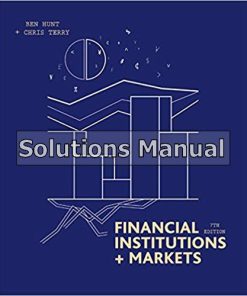Financial Institutions Instruments and Markets 8th Edition Viney Solutions Manual
$50.00 Original price was: $50.00.$26.50Current price is: $26.50.
Financial Institutions Instruments and Markets 8th Edition Viney Solutions Manual.
This is completed downloadable of Financial Institutions Instruments and Markets 8th Edition Viney Solutions Manual

Product Details:
- ISBN-10 : 1743079958
- ISBN-13 : 978-1743079959
- Author: Christopher Viney Mr (Author), Peter Phillips (Author)
The eighth edition of Financial Institutions, Instruments and Markets sees well-regarded authors Christopher Viney and Peter Phillips team up once again to deliver the latest information in financial institutions management. The new edition includes changes to important market items, updated discussions of the GFC, Murray report, Basel II and III, updated and expanded treatment of futures, derivatives markets and regulatory reforms, as well as an entire new discussion on behavioural finance.
To ensure the content’s relevancy and applicability, 21 new Australian and international case studies illustrate the material covered in each chapter, while the integrated worked examples and in-chapter exercises all further students’ learning.
The latest edition of Financial Institutions, Instruments and Markets is more user-friendly than ever – the structure of the content better aligns with teaching units so specific content is easily located while the design and layout of the text has been updated for readability.
Table of Content:
The finance is the lifeblood of an organization. Without it, it cannot exist. Business or ideas need the funds to grow. While the initial capital is provided by the various small sources such as seed capital, angel fund, venture capital, etc.
But for the larger scale, the business needs more funds and for that, they go for formal sources of financing which includes financing from the bank as a loan which is most common and traditional as well. Apart from this source, other sources can be equity financing, retained earnings, issue of hybrid instrument, etc.
Finance needs will arise for various time periods. The short term generally ranges up to 12 months. They are short term in nature. Medium-term for 12 months to 36 months. The long term for more than 36 months. However, there are inconsistencies among the various authors in the medium term and long term. Many classify only in two categories short term and long term.
The following are the principles of finance:-
1. Cash flow – This principle says that in business there should be the optimum cash
flows. The relatively higher cash flow into the business is preferred over the cash
outflow. The earlier and higher the cash inflow is better for the firm.
2. Hedge – According to this principle, there should be a matching between the
sources of finance and project needs. For example, short term financial needs
should
be provided for the shorter projects and in the same way the others.
3. Diversity – To minimize the risk associated with a particular project, the business
needs to diversify. Investing in one business can be dangerous it does not work
well. In that situation, the return of capital can become tedious.
4. Liquidity and profitability – This principle works better for investors. The
should investment into the market ready instruments. They should be quickly
liquidated in the market. Those invested avenues should be profitable enough to
make the investment worth. So, the investor must choose these two points
carefully.
5. Risk and return – It is the most common among all. The investor needs more
return if they are associating with the risky projects. So if the company is working
in a niche market or for some innovating field especially technology one, then the
cost of funds for them may be higher, If the company is working in a very generic
category like FMCG (Fast-moving consumer goods), then their cost can be
relatively low.
6. Time value – There is a time value associated with the funds. The funds received
today is much more important than the one received one year later. Therefore, the
company should try to make more cash inflow earlier in the period than the later
years.
These principles are important both for the investors and the company or the firm who needs them. For an investor, it is hard-earned money for them. Investing those funds in weaker assets without any careful consideration may be bad for them. So, they should take care of all these principles before investing.
For the company, these principles are also important. These guides them to select the sources of finance. Because, if the cost is higher then there may be difficulty in paying them. This will mark a bad impression on the company and their operations may be hampered.
People Also Search:
financial institutions instruments and markets viney
financial institutions instruments and markets 8th edition viney
financial institutions instruments and markets 8th edition
financial institutions instruments and markets 8th edition download scribd
financial institutions instruments and markets 8th edition solution manual download pdf
Instant download after Payment is complete
You may also like…
Solutions Manual
Financial Institutions and Markets 7th Edition Hunt Solutions Manual
Related products
Solutions Manual
Accounting For Governmental And Nonprofit Entities 18th Edition Reck Solutions Manual
Solutions Manual
Accounting Information Systems 10th Edition Hall Solutions Manual
Solutions Manual
Solutions Manual
A+ Guide to IT Technical Support Hardware and Software 9th Edition Andrews Solutions Manual
Solutions Manual
Accounting Texts and Cases 13th Edition Anthony Solutions Manual
Solutions Manual
Accounting for Governmental and Nonprofit Entities 15th Edition Wilson Solutions Manual
Solutions Manual




















